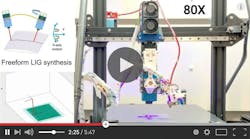3D printer + laser = next step in additive manufacturing innovation
Long-time readers of this blog will know that I’ve been wanting a 3D printer for over a decade. So, what’s stopping me from buying one? Sure, I don’t really have room for it in my workshop, but that’s never stopped me from investing in bulky, single-use tools. True, I don’t have a need for one, although I would say having the ability to print unique action figures at will counts as a need. What’s really holding me back from opening my wallet and taking the leap is the speed of innovation within the additive manufacturing sphere. Every time I check my email, there’s a new announcement illustrating how 3D printing is getting better, faster, and more precise. In a crossover episode that even I wasn’t expecting, 3D printing is now being outfitted with laser technology to produce multi-material, multi-layered structures.
Researchers at the University of Missouri (Mizzou) have introduced the Freeform Multi-material Assembly Process (FMAP), which utilizes a single machine and various materials like plastics, metals, and semiconductors to construct complex devices. The process combines two structural technologies, 3D printing and lasers, to create multi-material, multi-layered sensors and circuit boards. Producing multi-layered structures using traditional, multi-step processes can be slow, costly, and wasteful.
Unlike other processes, FMAP offers users the potential to print sensors embedded within a structure. This includes textiles with electronic components, everyday objects with temperature and pressure sensors, and wearable devices that can monitor vital signs.
In a recent quote, Jian “Javen” Lin, an associate professor of mechanical and aerospace engineering at Mizzou, said, “This opens the possibility for entirely new markets. It will have broad impacts on wearable sensors, customizable robots, medical devices and more.”
The team published their findings in Nature Communications. The paper, titled “Programmed multimaterial assembly by synergized 3D printing and freeform laser induction,” explores the far-reaching implications of the Freeform Multi-material Assembly Process. In an excerpt from the paper, the team writes: “This paper showcases the versatility of FMAP in spatially fabricating various types of functional materials (metals, semiconductors) within 3D structures for applications in crossbar circuits for LED display, a strain sensor for multifunctional springs and haptic manipulators, a UV sensor, a 3D electromagnet as a magnetic encoder, capacitive sensors for human machine interface, and an integrated microfluidic reactor with a built-in Joule heater for nanomaterial synthesis. This success underscores the potential of FMAP to redefine 3D printing and FLI for programmed multimaterial assembly.”
A recent press release from Mizzou details how the unique process works. The machine features three nozzles that:
- Add ink-like material to the project
- Use a laser to carve shapes and materials
- Add additional functional materials to enhance the product's capabilities
According to the release, “It starts by making a basic structure with regular 3D printing filament, such as polycarbonate, a type of transparent thermoplastic. Then, it switches to laser to convert some parts into a special material called laser-induced graphene, putting it exactly where it's needed. Finally, more materials are added to enhance the functional abilities of the final product.”
The Lighter Side of Manufacturing
Created by the editors of Plant Services and New Equipment Digest, The Lighter Side of Manufacturing is a feel-good blog that showcases how advances in science, math, engineering, and technology are making our world more whimsical. Here’s another post that is guaranteed to brighten your day.
DIY robot can mimic and replicate your actions in just 40 hours
Researchers have engineered a robot that, once shown a desired movement, will mimic and learn how to perform the action itself. It’s equal parts ingenious and creepy.
